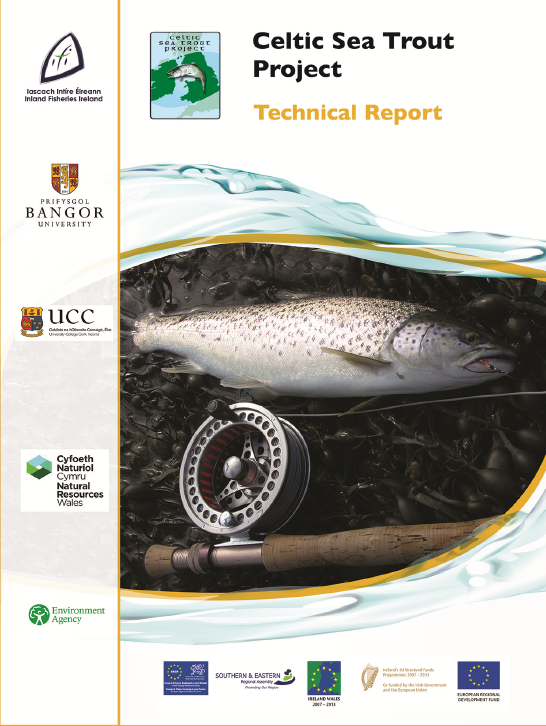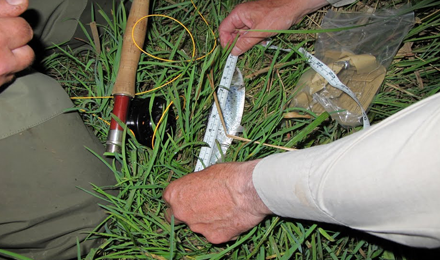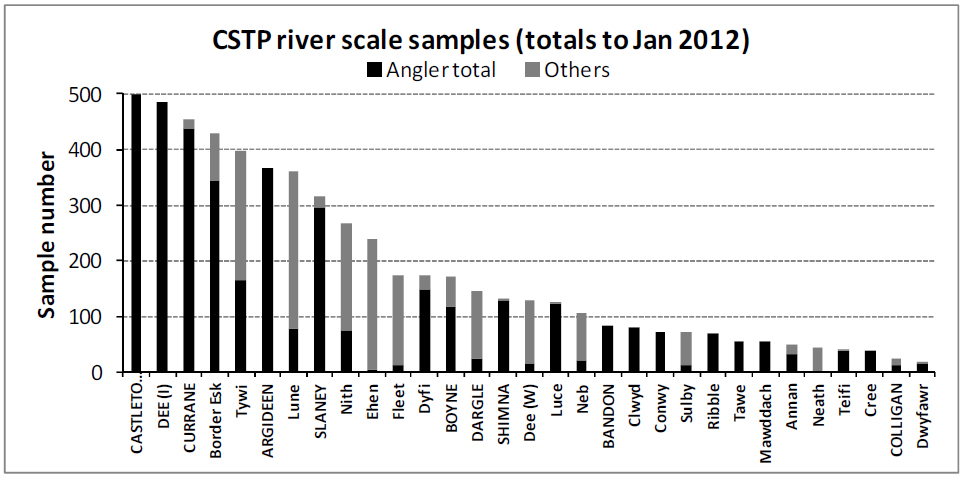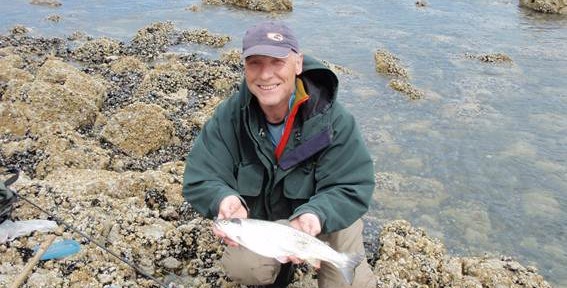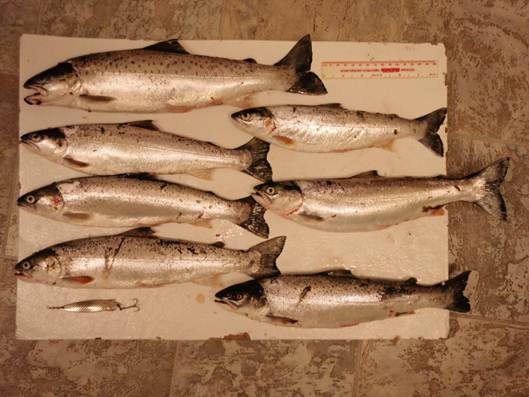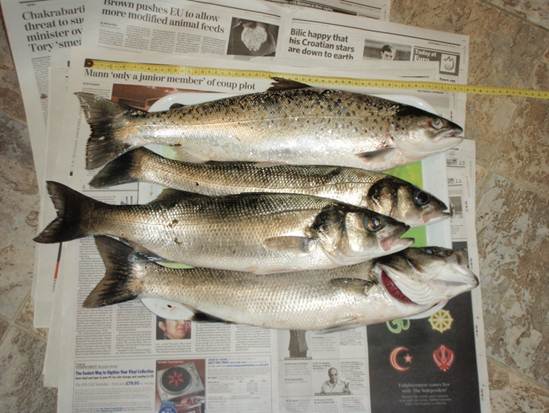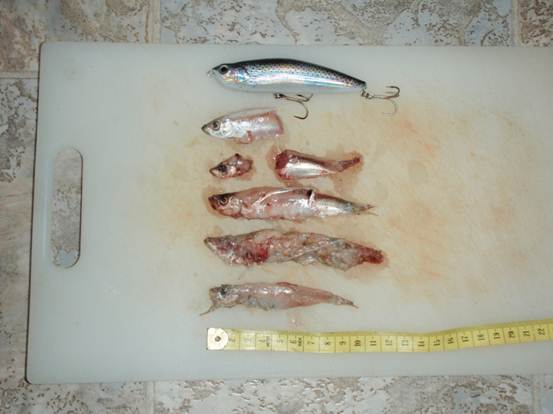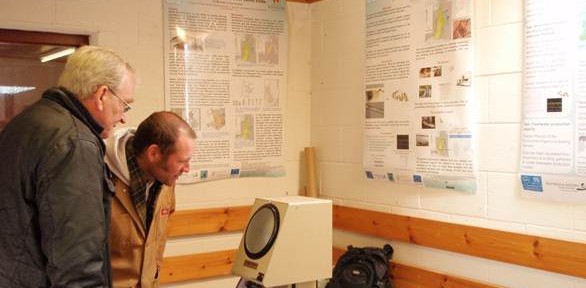The CSTP was an Interreg IVA funded project, running from 2009 to April 2013, intended to improve the management and long term future of sea trout in the Celtic seas by providing information and management advice, and by establishing a wider awareness and long term network of people working to secure the future of sea trout.
The project was delivered through the Ireland-Wales Cross-Border partnership; but because of the wide-ranging distribution of sea trout, work was carried around the Irish Sea in a multi-partner collaboration. Participants were Bangor University, Inland Fisheries Ireland, University College Cork, The Environment Agency Wales and the EA England, Isle of Man Government, Nith District Salmon Fisheries Board, Galloway Fisheries Trust, Annan District Salmon Fisheries Board and Buccleuth Estate (Border Esk). Subcontractors included APEM Ltd, Cefas and Fishskill Many other groups gave support and major feature of the programme was sampling of sea trout by anglers throughout the participating countries.
The work was split into 7 tasks:
- (1) management and dissemination,
- (2) review of fisheries,
- (3) Sampling,
- (4) microchemistry,
- (5) genetics,
- (6) Freshwater production and
- (7) Ecology, life histories, modelling for management.
Five key questions to answer, some addressed by multiple tasks, were:
- Are sea trout populations structured (i.e. systematically organised, not randomly distributed) around the area, if so how much and therefore what marine movement and exchange does this indicate?
- How and why does sea trout abundance vary over time and between regions and rivers?
- How do life histories and therefore the stock structure (size and age composition) vary amongst different fisheries and over time, in particular how does growth vary (growth rate being a dominant performance factor for fish)?
- How does feeding vary around the area (enhanced feeding being a major factor in determining the benefit of trout migration to the sea)?
- How can this information be assembled to offer better decision making and management advice using models based on population dynamics and responding to environmental factors, principally climate change, this being an explicit theme of this Interreg programme?
The CSTP has made progress against all these questions and an outline of the results is given below. An Interreg Report has been completed and submitted to the EU and work is continuing to complete a Technical Report by October 2013. The huge amount of information gathered offers scope for even further work in the future. This note is an interim outline for information, pending the final full report.
Question 1 Stock structuring.
Genetics was used to establish a genetic baseline of sea trout in 99 rivers by sampling juvenile trout in nursery streams. Sea trout sampled in different parts of the Irish Sea could then be genetically profiled and assigned back to their region/river of origin. By this means it was possible to get a picture of where fish caught at the sea originated from and where they would, probably, have returned to spawn (we know from other work that sea trout home tightly to their natal river). There are many caveats and sources of uncertainty in this work, but in essence there were found to be nine principal regional groups within the data set and clear differences in the areas that these groups occupied during their feeding migration, although there were also examples of substantial exchange rates between them. The micro-chemistry data (based on the chemical composition of scales which take on the fingerprint of the environment that fish live in) broadly supported this spatial structuring.
Question 2. Abundance variation
This work was based on the long term variation in rod catch data. The quality and detail of catch recording varies greatly around the area which limited this analysis, and fishing effort data, which is an important influence on catches, was often missing. However even with these constraints is was apparent that sea trout abundance tracked closely amongst regions and countries (eastern Ireland, Wales, southwest Scotland and northwest England). While there were some significant river specific variations, this pointed to some common factors acting on catches and possibly stocks. Between-river variations in abundance were huge, as is well known. Clearly, river size and associated fishing effort are dominant factors controlling catch; but there are other factors some of which were explored through task 6. Particularly, chemical productivity of the water and land cover type seemed to influence sea trout fishery status, rivers with low alkalinity with higher cover of forest and less intensive land use types tending to be the better sea trout rivers
Question 3. Life histories, growth and stock structure
This information came from an extensive scale reading programme coupled with measurements of fish size. Scale reading can reveal the age of a fish at capture and at smolting, its growth rate in different years and its previous breeding schedule. These are essential pieces of information in building models of how population size varies which are indispensible for good management. In addition, scale sample size and quality are important to produce acceptable unbiased information on the composition of each river stock. It proved extremely hard to get consistent scale reading across the participating teams, given the wide variety of prevalent life histories seen in the area. Not all rivers gave sufficient samples, but adequate data came from around 20 rivers. A number of improvements in methods were developed, and the data sets are still being subject to quality checking; but again a broad pattern is already evident. This was of faster growth and higher survival (more multiple spawners) in southern Wales rivers; high survival, but somewhat slower growth in the northwest England and southwest Scotland (Cumbria and Galloway) rivers and lower survival off the Irish coast, where finnock (fish returning in the same year that they smolted) dominated the runs in most rivers. The Currane in southwest Ireland, was a notable exception with a high proportion of long-lived adult sea trout. An unexpected result was the high degree to which sea trout continue to feed and grow during winter months at sea. Growth analysis is still continuing, but the strong influence of water temperature is evident with faster growers in the warmer areas. However, this is a complex pattern, and hydrodynamic modelling (computer projections of likely positions of migrating fish, based on tides and current patterns in the Irish Sea) coupled with the genetic data is being used to piece together the growth of the fish moving between areas of different temperature.
Question 4. Feeding
Sea trout go to sea to put on rapid growth, which they achieve through a high fat content fish diet. Sandeels and sprat are by far the dominant prey items, with a much smaller proportion of other fish species and crustaceans. There appear to be differences in diet composition between different regions of the Irish Sea which will also affect the growth opportunities for different stocks. Because of its link with growth, prey abundance might be expected to affect the abundance of sea trout as well as many other creatures such as birds, which depend on this crucial link in the food chain. However, the important question about how prey abundance itself varies over time cannot be answered because there is limited monitoring of sandeel, sprat or other small prey fish species in the Irish Sea; this is clearly an aspect to be looked into.
Question 5 How to offer better management advice
Mathematical models are routinely used to project forward, or to hindcast, the composition and abundance of marine fish stocks and salmon. With such models, when adequately set up, one can estimate how stocks might respond to altered fishing regulations and potentially to environmental factors such as changing temperature or food availability. These models must also consider the uncertainties which stem from the quality of the source data and in the level of understanding of the specific processes governing each part of the life cycle. Such modelling is the last stage in the CSTP and depends upon the results of the other activities. Doing this for sea trout is a tall order, because of the particularly variable life history of the species (far more variable than Atlantic salmon). Nevertheless some significant advances are anticipated in this and will be reported in due course and made available for practical application by fishery managers. Simply assembling better descriptions of growth, age and size structure and fecundity is a major step forward and this is already available.
Overall
The CSTP has produced new and valuable information, as well as a stored permanent archive including data, a scale collection and other samples that will be available for future studies. Its primary purpose of improving understanding of sea trout stocks in order to support better management has been achieved. Many questions remain and some new ones have emerged, but the base that the CSTP has established will greatly assist in addressing these as resources become available in the future. The project did not aim to manage individual stocks, which would be impossible on such a scale and impracticably due to contrasting regulatory infrastructure and legislation across the countries. That important work remains the responsibility of the competent local agencies and groups. Rather, the CSTP focus has been on applied science and its application in management and on developing knowledge that has wide, generic application around the Irish Sea. Such a wide-scale comprehensive, cross-disciplinary project has not been carried out before on sea trout in the British Isles. Consequently, there have been some important scientific developments in studies of sea trout genetics, microchemistry and population dynamics which will lead to further advances, as resources allow. Recommendations will be made on these and also on several practical aspects of sea trout monitoring and assessment where lessons have been learnt from this project.
Finally, the project team would like to extend sincere thanks to the hundreds of anglers, netsmen and other interested people who contributed through providing fish samples, or in other ways.
